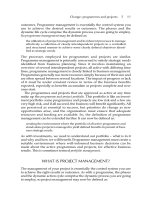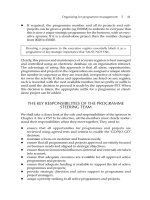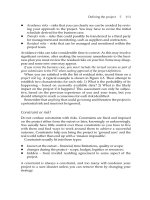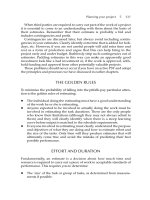The Compensation Handbook. A State-of-the-Art Guide to Compensation Strategy and Design
Bạn đang xem bản rút gọn của tài liệu. Xem và tải ngay bản đầy đủ của tài liệu tại đây (5.36 MB, 698 trang )
THE
COMPENSATION
HANDBOOK
FIFTH
EDITION
A S TATE - OF - THE -A RT
G UIDE TO
C OMPENSATION
S TRATEGY AND D ESIGN
LANCE A. BERGER and DOROTHY R. BERGER
New York San Francisco Washington, D.C. Auckland Bogotá
Caracas Lisbon London Madrid Mexico City Milan
Montreal New Delhi San Juan Singapore
Sydney Tokyo Toronto
Copyright © 2008 by The McGraw-Hill Companies, Inc. All rights reserved. Manufactured in the United States of America. Except
as permitted under the United States Copyright Act of 1976, no part of this publication may be reproduced or distributed in any form
or by any means, or stored in a database or retrieval system, without the prior written permission of the publisher.
0-07-164287-0
The material in this eBook also appears in the print version of this title: 0-07-149675-0.
All trademarks are trademarks of their respective owners. Rather than put a trademark symbol after every occurrence of a trademarked name, we use names in an editorial fashion only, and to the benefit of the trademark owner, with no intention of infringement of the trademark. Where such designations appear in this book, they have been printed with initial caps.
McGraw-Hill eBooks are available at special quantity discounts to use as premiums and sales promotions, or for use in corporate
training programs. For more information, please contact George Hoare, Special Sales, at or (212)
904-4069.
TERMS OF USE
This is a copyrighted work and The McGraw-Hill Companies, Inc. (“McGraw-Hill”) and its licensors reserve all rights in and to the
work. Use of this work is subject to these terms. Except as permitted under the Copyright Act of 1976 and the right to store and
retrieve one copy of the work, you may not decompile, disassemble, reverse engineer, reproduce, modify, create derivative works
based upon, transmit, distribute, disseminate, sell, publish or sublicense the work or any part of it without McGraw-Hill’s prior consent. You may use the work for your own noncommercial and personal use; any other use of the work is strictly prohibited. Your right
to use the work may be terminated if you fail to comply with these terms.
THE WORK IS PROVIDED “AS IS.” McGRAW-HILL AND ITS LICENSORS MAKE NO GUARANTEES OR WARRANTIES
AS TO THE ACCURACY, ADEQUACY OR COMPLETENESS OF OR RESULTS TO BE OBTAINED FROM USING THE
WORK, INCLUDING ANY INFORMATION THAT CAN BE ACCESSED THROUGH THE WORK VIA HYPERLINK OR OTHERWISE, AND EXPRESSLY DISCLAIM ANY WARRANTY, EXPRESS OR IMPLIED, INCLUDING BUT NOT LIMITED TO
IMPLIED WARRANTIES OF MERCHANTABILITY OR FITNESS FOR A PARTICULAR PURPOSE. McGraw-Hill and its
licensors do not warrant or guarantee that the functions contained in the work will meet your requirements or that its operation will
be uninterrupted or error free. Neither McGraw-Hill nor its licensors shall be liable to you or anyone else for any inaccuracy, error
or omission, regardless of cause, in the work or for any damages resulting therefrom. McGraw-Hill has no responsibility for the content of any information accessed through the work. Under no circumstances shall McGraw-Hill and/or its licensors be liable for any
indirect, incidental, special, punitive, consequential or similar damages that result from the use of or inability to use the work, even
if any of them has been advised of the possibility of such damages. This limitation of liability shall apply to any claim or cause whatsoever whether such claim or cause arises in contract, tort or otherwise.
DOI: 10.1036/0071496750
Professional
Want to learn more?
We hope you enjoy this
McGraw-Hill eBook! If
you’d like more information about this book,
its author, or related books and websites,
please click here.
For more information about this title, click here
Contents
Preface vii
About the Editors
Contributors
xi
ix
Part 1 Introduction
1 Employee Pay: A Riddle Wrapped in a Mystery Inside an Enigma
Lance A. Berger
3
2 Total Rewards and the Future Workforce
Steven E. Gross and Shelley Peterson
11
3 Total Rewards Strategy
Thomas B. Wilson
21
4 Three Trends Shaping the Future of Compensation and
Human Resources
Allan Schweyer
5 Demographics: The Tempest Driving Compensation
Dorothy R. Berger
31
49
Part 2 Base Salary
6 Salary Administration
Andrew S. Rosen
63
7 Merit Pay
Myrna Hellerman and James Kochanski
85
8 Job Analysis, Documentation, and Job Evaluation
Bernard Ingster, Ph.D.
95
9 Salary Surveys
Don York and Tim Brown
111
iii
CONTENTS
iv
10 Benchmarking
Iain Fitzpatrick and Thomas D. McMullen
125
11 Skills, Knowledge, and Competency-Based Pay
Gerald E. Ledford, Jr, Ph.D., Robert L. Heneman, Ph.D. and Aino Salimäki
143
12 Broadbanding
Kenan S. Abosch
159
13 Nonmonetary Awards
Rodger D. Stotz and Melissa Van Dyke
167
14 Salary Administration at a Prestigious Cultural Institution:
Pennsylvania Academy of the Fine Arts
Leslie Moody
187
15 Compensation Practices in a Middle Market Company
David E. Griffith
191
16 A Vision for Information Technology in Compensation
Steven T. McGuire
197
Part 3
Variable Compensation
17 Incentive Compensation Program Design
Linda E. Amuso and David Knopping
205
18 Using Variable Pay Programs to Support Organization Goals
Erin C. Packwood
215
19 Rationalizing Variable Pay Plans
Kenan S. Abosch
227
20 Sales Compensation
Jerome A. Colletti and Mary S. Fiss
239
21 Team-Based Incentives
Theresa M. Welbourne, Ph.D. and Luis R. Gomez-Mejia, Ph.D.
259
22 Gainsharing or Profit Sharing
Robert L. Masternak
277
23 Scanlon Gainsharing
Paul Davis and Dow Scott, Ph.D.
295
Part 4
Executive Compensation
24 Executive Compensation Strategy
Ted Buyniski and Marvin A. Mazer
311
25 Long-Term Incentives
Jeffrey S. Hyman, Esq.
323
CONTENTS
v
26 Executive Compensation: A Recruiter’s Recommendations
Randy Jayne
339
27 Executive Compensation: An Academic’s Perspective
Johannes M. Pennings, Ph.D.
349
28 Regulation of Executive Compensation
Frank P. VanderPloeg, Esq.
365
29 Executive Employment Agreements
Richard L. Alpern
385
Part 5
Compensation and the Board
30 The Compensation Committee and Executive Pay
Seymour Burchman and Blair Jones
397
31 New Dynamics of CEO Pay
David N. Swinford
415
32 Board Compensation
Pearl Meyer and Nora McCord
423
33 Board Critical Issues in Executive Pay
Bruce R. Ellig
433
Part 6
Performance and Compensation
34 Performance Management Best Practices
Thomas B. Wilson and Susan Malanowski
447
35 Guidelines for Effective Executive Performance Appraisals
James F. Reda
459
36 Forced Ranking
Dick Grote
479
37 The Balanced Scorecard and Compensation
Paul R. Niven
493
38 Performance Metrics and Compensation
Mark Graham Brown
511
39 Using Compensation to Drive Workforce Productivity
Christian M. Ellis and Summer F. Barnes
521
40 Return on Investment of Compensation Expenditures
Fred Whittlesey
531
41 Pay-for-Performance: New Developments and Issues
Mark D. Cannon, Ph.D.
543
CONTENTS
vi
Part 7
Talent Management and Compensation
42 Using Compensation to Win the Talent Wars
Deborah Rees
559
43 Talent Management, Organization Transformation, and Compensation
Lance A. Berger
571
44 Work–Life Effectiveness and Total Rewards Strategy
Kathleen M. Lingle
585
45 Compensating and Motivating a Diverse Workforce
Martin G. Wolf, Ph.D.
597
46 Communicating Compensation Programs
John A. Rubino
607
47 Talent Management and Compensation in the Fast Food Industry
Jerry M. Newman
617
Part 8
Global Compensation
48 Expatriate Compensation Practices
Geoffrey W. Latta
627
49 Global Local National Compensation Practices
Paul Coleman
641
50 Global Compensation Processes
Robert Mattson and David Turetsky
653
Index
665
Preface
HE COMPENSATION HANDBOOK HAS BEEN recognized as
the most authoritative reference book in the compensation field for over
35 years.
T
The book’s success has resulted from:
■
Identifying the most significant issues impacting compensation and human
resources practitioners
■
Providing the best straightforward, comprehensive, and understandable
solutions to deal with issues
■
Presenting the thoughts and research of respected and prestigious compensation leaders
■
Offering unique and innovative approaches not found elsewhere
■
Building on the strong foundation of past editions
■
Imparting the best historical and current compensation tools, methods, and
diagnostics for compensation and human resources professionals to align
their programs with key issues
Each edition of the book has its own novel foundation. The first three editions
focused on the evolution of new compensation techniques and methodologies as
they applied to the business and social environment of their eras. The fourth edition
is based on a framework of compensation diagnostics. It structures prior and current approaches into a cohesive set of guiding principles that helps practitioners
to select the most appropriate compensation methodology.
vii
Copyright © 2008 by The McGraw-Hill Companies, Inc. Click here for terms of use.
PREFACE
viii
The fifth edition’s objective is to demonstrate to human resources and compensation professionals how they can address a dramatically changing set of
human capital issues. These include:
■
New strategies for winning the talent wars
■
Addressing the retirement of the baby boomers, the greatest talent management issue of the twenty-first century
■
Responding to a multicultural, multigenerational workforce
■
The globalization of human capital
Thanks to the contributions of 64 compensation specialists, 45 of whom are
new authors to The Compensation Handbook, this edition contains new, updated,
or revised chapters. This “linkage” to talent management issues provides common threads and a roadmap for developing a comprehensive approach to compensation program design and implementation. The fourth edition’s structural
integrity is maintained because our readers have expressed their appreciation of
consistency when seeking updated information and solutions to compensation
issues.
We again, as we did for the fourth edition, dedicate this book with appreciation and affection to Milton L. Rock, consummate compensation and business
guru, whose vision spearheaded the first through third editions of The
Compensation Handbook.
Dorothy R. Berger
Lance A. Berger
About the Editors
Lance A. Berger is CEO of Lance A. Berger & Associates, Ltd., a Bryn Mawr,
Pennsylvania management consultant firm specializing in compensation, talent
management, and change management. A former general partner for the largest
compensation practice worldwide at The Hay Group, he cowrote Management
Wisdom from the New York Yankees’ Dynasty and Deengineering The Corporation,
and cowrote and coedited the third and fourth editions of The Compensation
Handbook, The Talent Management Handbook, and The Change Management
Handbook.
Dorothy R. Berger is Managing Director of Lance A. Berger & Associates, Ltd.
She coordinates all organizational activities for the firm and is also a talent management consultant. She cowrote Management Wisdom from the New York
Yankees’ Dynasty, and cowrote and coedited The Compensation Handbook, fourth
edition, The Talent Management Handbook, The Change Management Handbook,
and Deengineering The Corporation. Dorothy has over 20 years’ experience in the
field of education.
ix
Copyright © 2008 by The McGraw-Hill Companies, Inc. Click here for terms of use.
This page intentionally left blank
Contributors
Kenan S. Abosch Broad-Based Compensation Practice Segment Leader,
Hewitt Associates, LLC, Lincolnshire, Illinois (Chapters 12 and 19)
Richard L. Alpern Principal, Frederic W. Cook & Company, Inc., New York,
New York (Chapter 29)
Linda E. Amuso Senior Vice President, Radford Surveys & Consulting,
An Aon Business, San Francisco, California (Chapter 17)
Summer F. Barnes Senior Consultant, Sibson Consulting, Los Angeles,
California (Chapter 39)
Dorothy R. Berger Managing Director, Lance A. Berger & Associates, Ltd,
Bryn Mawr, Pennsylvania (Chapter 5)
Lance A. Berger Chief Executive Officer, Lance A. Berger & Associates, Ltd,
Bryn Mawr, Pennsylvania (Chapters 1 and 43)
Mark Graham Brown President, Mark Graham Brown & Associates,
Manhattan Beach, California (Chapter 38)
Tim Brown Vice President, Radford Surveys & Consulting, An Aon Business,
San Jose, California (Chapter 9)
Seymour Burchman Managing Principal, Semler Brossy Consulting Group,
LLC, Los Angeles, California (Chapter 30)
Ted Buyniski Senior Vice President, Radford Surveys & Consulting, An Aon
Business, Southborough, Massachusetts (Chapter 24)
Mark D. Cannon, Ph.D. Associate Professor of Leadership and Organizational
Studies, Peabody College, Vanderbilt University, Nashville, Tennessee (Chapter 41)
Paul Coleman Senior Consultant, ORC Worldwide, London, UK (Chapter 49)
Jerome A. Colletti Colletti–Fiss, LLC, Scottsdale, Arizona (Chapter 20)
Paul Davis President, Scanlon Leadership Network, East Lansing, Michigan
(Chapter 23)
Bruce R. Ellig Author and retired Corporate Vice President, HR, Pfizer Inc.,
New York, New York (Chapter 33)
Christian M. Ellis Senior Vice President, Sibson Consulting, Los Angeles,
California (Chapter 39)
xi
Copyright © 2008 by The McGraw-Hill Companies, Inc. Click here for terms of use.
xii
CONTRIBUTORS
Mary S. Fiss Colletti–Fiss, LLC, Scottsdale, Arizona (Chapter 20)
Iain Fitzpatrick Reward Information Services General Manager, Hay Group,
Philadelphia, Pennsylvania (Chapter 10)
Luis R. Gomez-Mejia, Ph.D. Professor of Management, W.P. Carey School of
Business, Arizona State University, Tempe, Arizona (Chapter 21)
David E. Griffith President and CEO, Modern Group Ltd, Bristol, Pennsylvania
(Chapter 15)
Steven E. Gross Worldwide Partner and Segment Leader, Broad-based
Performance and Rewards Segment Leader, Mercer Human Resources
Consulting, Philadelphia, Pennsylvania (Chapter 2)
Dick Grote President, Grote Consulting Corporation, Dallas, Texas (Chapter 36)
Myrna Hellerman Senior Vice President, Sibson Consulting, Chicago, Illinois
(Chapter 7)
Robert L. Heneman, Ph.D. Professor of Management and Human Resources,
Max M. Fisher College of Business, Ohio State University, Columbus, Ohio
(Chapter 11)
Jeffrey S. Hyman, Esq. Exequity LLP, Wilton, Connecticut (Chapter 25)
Bernard Ingster, Ph.D. Consultant, Human Resources Management,
Philadelphia, Pennsylvania (Chapter 8)
Randy Jayne Managing Partner Global Aerospace, Defense, and Aviation
Practice, Heidrick & Struggles, McLean, Virginia (Chapter 26)
Blair Jones Managing Principal, Semler Brossy Consulting Group, LLC,
Los Angeles, California (Chapter 30)
David Knopping Vice President, Radford Surveys & Consulting, An Aon
Business, San Francisco, California (Chapter 17)
James Kochanski Senior Vice President, Sibson Consulting, Raleigh,
North Carolina (Chapter 7)
Geoffrey W. Latta Executive Vice President, ORC Worldwide, New York,
New York (Chapter 48)
Gerald E. Ledford, Jr., Ph.D. President, Ledford Consulting Network, LLC,
Redondo Beach, California (Chapter 11)
Kathleen M. Lingle Director, Alliance for Work–Life Progress, WorldatWork,
Scottsdale, Arizona (Chapter 44)
Susan Malanowski Principal, Wilson Group, Inc., Concord, Massachusetts
(Chapter 34)
Robert L. Masternak President, Masternak & Associates, Medina, Ohio
(Chapter 22)
CONTRIBUTORS
xiii
Robert Mattson Product Marketing, Workscape, Marlborough, Massachusetts
(Chapter 50)
Marvin A. Mazer Senior Vice President, Radford Surveys & Consulting,
An Aon Business, Atlanta, Georgia (Chapter 24)
Nora McCord Consultant, Steven Hall & Partners, New York, New York
(Chapter 32)
Steven T. McGuire Manager, Human Resources, GlaxoSmithKline,
Philadelphia, Pennsylvania (Chapter 16)
Thomas D. McMullen Vice President and Reward Practice Leader, Hay
Group, Chicago, Illinois (Chapter 10)
Pearl Meyer Senior Managing Director, Steven Hall & Partners, New York,
New York (Chapter 32)
Leslie Moody Senior Vice President of Human Resources and Administration,
Pennsylvania Academy of the Fine Arts, Philadelphia, Pennsylvania (Chapter 14)
Jerry M. Newman Distinguished Teaching Professor and Chair Department of
Organization and Human Resources, State University of New York at Buffalo,
Buffalo, New York (Chapter 47)
Paul R. Niven President, The Senalosa Group, Inc., Ramona, California
(Chapter 37)
Erin C. Packwood Principal, Mercer Human Capital Consulting Group,
Houston, Texas (Chapter 18)
Johannes M. Pennings, Ph.D. Department of Management, The Wharton
School, University of Pennsylvania, Philadelphia, Pennsylvania (Chapter 27)
Shelley Peterson Senior Associate Broad-based Performance and Rewards,
Mercer Human Resources Consulting, Philadelphia, Pennsylvania (Chapter 2)
James F. Reda Managing Director, James F. Reda & Associates, LLC,
New York, New York (Chapter 35)
Deborah Rees Director, Innecto Reward Consulting, Woodborough, UK
(Chapter 42)
Andrew S. Rosen Vice President, ORC Worldwide, New York, New York
(Chapter 6)
John A. Rubino President, Rubino Consulting Services, Pound Ridge,
New York (Chapter 46)
Aino Salimäki Researcher, Helsinki University of Technology, Helsinki,
Finland (Chapter 11)
Dow Scott, Ph.D. Professor of Human Resources, Loyola University Chicago,
Chicago, Illinois (Chapter 23)
xiv
CONTRIBUTORS
Allan Schweyer President and Executive Director, The Human Capital
Institute, Quebec, Canada (Chapter 4)
Rodger D. Stotz Vice President and Managing Consultant, Maritz, Inc.,
Fenton, Missouri (Chapter 13)
David N. Swinford President, Pearl Meyer & Partners, New York, New York
(Chapter 31)
David Turetsky Director of Product Management, Workscape, Marlborough,
Massachusetts (Chapter 50)
Frank P. VanderPloeg, Esq. Partner, Employee Benefits and Executive
Compensation, Sonnenschein Nath & Rosenthal, Chicago, Illinois (Chapter 28)
Melissa Van Dyke Consultant, Maritz, Inc., Fenton, Missouri (Chapter 13)
Theresa M. Welbourne, Ph.D. Adjunct Professor of Executive Education,
Ross School of Business, University of Michigan, Ann Arbor, Michigan;
President and CEO, eePulse, Inc., Ann Arbor, Michigan (Chapter 21)
Fred Whittlesey Principal Consultant, Compensation Venture Group, Inc.,
Bainbridge Island, Washington (Chapter 40)
Thomas B. Wilson President, Wilson Group, Inc., Concord, Massachusetts
(Chapters 3 and 34)
Martin G. Wolf, Ph.D. President, Management Advisory Services, Inc.,
Jalisco, Mexico (Chapter 45)
Don York Senior Vice President, Radford Consulting & Surveys, An Aon
Business, San Jose, California (Chapter 9)
P
1
A
R
T
Introduction
Copyright © 2008 by The McGraw-Hill Companies, Inc. Click here for terms of use.
This page intentionally left blank
C
H
1
A
P
T
E
R
EMPLOYEE PAY: A
RIDDLE WRAPPED
IN A MYSTERY INSIDE
AN ENIGMA
Lance A. Berger, Chief Executive Officer
Lance A. Berger & Associates, Ltd
T
O MOST EMPLOYEES WINSTON CHURCHILL could have been
describing their pay package instead of Russia when he said that “it was
a riddle wrapped in a mystery inside an enigma.” The purpose of this
chapter is to solve the riddle by unwrapping the mystery and explaining
the enigma.
To employees the most recognizable deliverable in a compensation program is
their own pay package. It is essential to the organization that this deliverable be
transparent. To the practitioner the challenge is to ensure transparency by rationalizing the employee’s pay package as the end result of an unambiguous, disciplined, and explainable thought process based on a coherent business and human
resources strategy. We will explain the enigma (how the pay components are
derived) by unwrapping three layers of mystery.
3
Copyright © 2008 by The McGraw-Hill Companies, Inc. Click here for terms of use.
THE COMPENSATION HANDBOOK
4
LAYER 1: A WINNING BUSINESS STRATEGY BEGINS
WITH A DEFINITION OF STRATEGY
A strategy is a risk management program for allocating major resources today
where the identified competitive opportunities and returns are in the future. Lance
A. Berger & Associates research indicates that a winning business strategy is based
on allocating major resources to accomplish the three goals outlined in Figure 1.1.
Successful organizations seek to answer the following three questions when
they develop action plans to address the three goals.
1. Continuous stakeholder satisfaction: Are the customers, employees, shareholders, suppliers, and vendors satisfied that their own goals have been and
will continue to be met?
2. Perpetual competitive advantage: Did the organization stay in the top three
of its competitive comparison group over time?
3. Sustained “employer of choice”: Do employees and candidates prefer the
organization to others as a place to work? Are turnover rates relatively low?
Does the organization have a performance-driven culture?
To help an organization answer these questions and achieve these goals, we need
to engage in strategic thinking from a human resources perspective. What is strategic thinking? Strategic thinking is the application of intuition, creativity, synthesis,
FIGURE 1.1
A winning business strategy
Continuous
stakeholder
satisfaction
Organizational
success
Sustained
“employer of
choice”
Copyright Lance A. Berger & Associates, Ltd.
Perpetual
competitive
advantage
EMPLOYEE PAY: A RIDDLE WRAPPED IN A MYSTERY INSIDE AN ENIGMA
5
and judgment to design a strategy. In this case we are applying strategic thinking
to create a human resources environment that supports the three objectives of a
winning business strategy.
LAYER 2: THE HR STRATEGY THAT SUPPORTS THE WINNING
BUSINESS STRATEGY IS BASED ON THE CREATION
OF A WINNING CULTURE
Before exploring the elements of a winning culture we must first define the meaning of culture. We define culture as the shared knowledge, experience, emotions,
beliefs, values, attitudes, meanings, and concepts developed, acquired, and transmitted by the people in an organization. Culture determines whether business
strategies can and/or will be supported at an employee’s personal risk level and
what reward systems will actually work in the culture. In our highly competitive
world the only acceptable culture is one that drives business excellence defined by
strategic goals. A culture of excellence is one in which people have shared knowledge, experience, emotions, beliefs, values, attitudes, meanings, and concepts that
contribute to business, group, and personal success now and in the future. Cultural
excellence enables an organization to be an “employer of choice,” perpetually
achieve competitive advantage, and continuously generate stakeholder satisfaction. There are three dimensions and several components of cultural excellence.
The three dimensions, expressed as competency clusters, are shown in Figure 1.2.
FIGURE 1.2
The three dimensions of cultural excellence
Business/
Professional
Cultural
Excellence
Personal
Copyright Lance A. Berger & Associates, Ltd.
Social
THE COMPENSATION HANDBOOK
6
The competencies (organizational and personal success factors) that comprise
these clusters are:
■
■
■
Business/professional—knowledge-based competencies needed to produce a
product or service (technical, functional), customer orientation, and results
orientation
Social—leadership, interpersonal skills, teamwork, citizenship (ethics and
morality)
Personal—creativity, communications, and risk tolerance
In many organizations culture evolves in a happenstance way largely through
a mosaic of unconnected and nonstrategic processes that affect how people are
hired, promoted, developed, and terminated. Culture is transmitted through
bureaucratic and perfunctory policies, processes, and employee manuals designed
to mechanically regulate daily work and employee behaviors. In a highly competitive world, however, organizations cannot let culture evolve in a haphazard way.
Companies must manage the creation, development, and sustenance of a culture of
excellence based on the behaviors associated with competency clusters such as
those cited above. It is only when employee behavior is connected to organizational success that its talent pool spawns a culture of excellence. All human
resources and compensation strategies must be transparently focused on driving
behaviors associated with a culture of organizational excellence.
Three talent management strategies drive the culture of excellence. These
strategies are shown in Figure 1.3.
FIGURE 1.3
Three talent management strategies
Superkeepers
Strategy
Resource
allocation
Copyright Lance A. Berger & Associates, Ltd.
Key position
back-ups
EMPLOYEE PAY: A RIDDLE WRAPPED IN A MYSTERY INSIDE AN ENIGMA
7
The three talent management strategies are defined as follows:
■
Cultivate a Superkeeper™ pool—the keepers of the flame for the culture of
excellence (2–3 percent of the workforce)
■
Enhance incumbents and handcuff strong backups in key/mission critical
positions (8–12 percent of positions are critical)
■
Allocate TREADs (training, rewards, education, and development) based on
current and future employee contribution (actual and potential achievement)
In order to allocate resources in accordance with a talent management
strategy such as that outlined above, an organization must be able to classify
every member of its workforce based on her actual and potential contribution to
success. Our research generated the following employee classifications.
1. Superkeeper™—demonstrates superior accomplishments; inspires others to
superior accomplishment; serves as the embodiment of organizational
competencies (about 2–3 percent of the workforce)
2. Keeper—exceeds expectations for performance; can lead others; exceeds
expectations on organizational competencies (about 20 percent of the
workforce)
3. Solid citizen—meets expectations for performance; can work with others;
meets expectations on organizational competencies (about 70 percent of the
workforce)
4. Misfit—does not meet expectations for performance; does not work well
with others; does not reflect institutional competencies (about 7 percent of
the workforce)
Most successful organizations generate their employees’ classifications based
on some combination of three types of assessment. These are: performance, competencies (current and future), and potential.
Performance. This is a measurement of actual results achieved within those
areas for which the employee is held accountable. All individual and group
performance measures must be woven into the fabric of organizational success
measures in order to connect the employee to institutional achievement.
Core/Institutional Competencies. These are behavioral/skill expectations that
are crucial to the success of each employee and to the success of the entire organization. Our research has determined that most organizations use between seven
and eleven institutional competencies in their assessment process. Typical core
competencies can be communications, innovation, critical judgment, customer
orientation, interpersonal skills, leadership, teamwork, and technical/functional
expertise.
THE COMPENSATION HANDBOOK
8
An example of an organization’s competency definition may be:
Communication: communicates well both verbally and in writing. Effectively
conveys ideas and shares information with others. Listens carefully and
understands different points of view. Presents ideas clearly and concisely and
understands relevant detail in presented information.
Competency definitions can further be differentiated into glossaries of behaviors
associated with each level of the organization. This provides amplification,
clarity, and greater specificity to the definition. As an example, when considering
communications all employees are required to clearly and appropriately express
their desires and needs, whereas in addition supervisors are expected to adapt
communications to audience requirements to optimize understanding, managers
are required to actively present information and ideas to all appropriate levels
and lead others to do the same, and individuals in top management are required to
promote open expression of ideas and encourage communication without retribution, assuming that they have mastered the behaviors outlined for lower-level
employees.
Potential. This is a prediction of how many levels (organization or job) an
employee can progress through based on their past/current/projected performance
appraisals, training and development needs, career preferences, and actual and
projected competency levels. Underlying the assessment of potential is the
employee’s desire to improve, need to achieve tangible results, probable acceptance by higher peer levels, self-confidence, and emotional stability.
LAYER 3: THE ORGANIZATION’S PAY STRATEGY IS
DEVELOPED AND IMPLEMENTED TO SUPPORT ITS TALENT
MANAGEMENT STRATEGY BUILT UPON ITS EMPLOYEE
CLASSIFICATION SYSTEM
In order to transparently deliver pay to each employee, in accordance with the
human resources strategy defined above it must first be filtered through a set of
principles known as a pay strategy. The five elements that compose a pay strategy
are: philosophy, pay/talent market, competitive level, mix, and contribution. The
definitions of rules for a pay strategy are discussed below.
Compensation Philosophy. Organizations customize their compensation
philosophy based on their particular business and human resources requirements.
Most commonly, these philosophies focus on delivering pay, based on institutional
affordability, in a way that enables them to attract, retain, and reward employee
performance in an equitable, competitive, and legal way. To complete the statement of philosophy, organizations are now adding the goal of “allocating pay
based on business and human resources strategies” such as those described above.
EMPLOYEE PAY: A RIDDLE WRAPPED IN A MYSTERY INSIDE AN ENIGMA
9
Pay/Talent Markets. In order to determine the competitiveness of pay associated
with a given position, an organization must survey its pay, or talent, market. A
pay/talent market consists of incumbents in institutions that have or will provide a
source of talent for, or would pirate talent from, an organization. The surveyed
compensation for people in benchmark (commonly found) jobs in a chosen talent
market should be the basis for establishing pay in an organization. The best
surveys are those that accurately measure a pay market derived from sources of
recruitment and exit interviews. Positions within a talent market that have no
survey counterpart can derive their value from a comparison of relative organizational worth with those jobs that can be surveyed. Note that pay/talent market
competitors may not necessarily be in the same business.
Competitive Level. Within each pay/talent market and within the organization
as a whole, management must determine the competitive level of total human
resources costs it can afford to pay to attract, retain, and reward its employees.
Competitive level is generally expressed as a percentile in surveys associated with
a given pay/talent market (25th, 50th, 75th). The total affordable pot of money is
the basis of allocation of pay. It is possible that the characteristics of different
pay/talent markets (supply and demand) will necessitate different pay structures
and competitive levels. Regardless, individual employees should be paid at competitive levels that reflect their own current and projected contribution (value) to
the organization.
Mix. The percentage of total pay targeted for each pay component (base salary,
annual incentives, and long-term incentives) defines its mix. Furthermore, within
a total pay package, there may be different competitive levels targeted for base,
annual incentives, long-term incentives, and total compensation. The greater the
amount of variable or non-base pay, the more leverage (upside opportunity) or risk
(non-guaranteed pay) becomes a factor in an employee’s compensation package.
In general, the level of risk or leverage decreases in employee pay packages as
organizational financial strength evolves from that of a perilous start-up to that of
a secure established organization. Within an organization the amount of leverage
in a pay package also reflects the risk and accountability associated with a given
position. Senior management and line positions typically have more variable pay
than staff positions. Figure 1.4 illustrates the typical mix of pay in organizations at
different stages of growth.
Contribution. This refers to the employee’s classification, based on her
assessed current and future organizational value, derived from factors such as
those previously defined (performance, competencies, and potential). The final
pay package architecture for a single employee is now in place. The employee’s
mix and competitive level of pay based on the characteristics of her own talent
market and consideration for her personal contribution can now be expressed in









